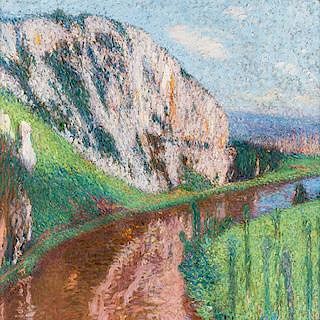MIR ISKUSSTVA [WORLD OF ART] Magazine. COMPLETE SET, 1899-1904
About Seller
566 East Boston Post Road
Mamaroneck, NY 10543
United States
Our auctions feature an impressive selection of fine art, decorative art, rare books, icons, militaria, and other objects from antiquity to the present. Shapiro Auctions advertises globally and has clients all over the world, while providing a rare combination of personal service and the ability to ...Read more
Two ways to bid:
- Leave a max absentee bid and the platform will bid on your behalf up to your maximum bid during the live auction.
- Bid live during the auction and your bids will be submitted real-time to the auctioneer.
Bid Increments
| Price | Bid Increment |
|---|---|
| $0 | $25 |
| $500 | $50 |
| $1,000 | $100 |
| $2,000 | $250 |
| $5,000 | $500 |
| $10,000 | $1,000 |
| $20,000 | $2,500 |
| $50,000 | $5,000 |
| $100,000 | $10,000 |
| $200,000 | $25,000 |
About Auction
Oct 18, 2017 - Oct 19, 2017
Shapiro Auctions info@shapiroauctions.com
- Lot Description
MIR ISKUSSTVA [WORLD OF ART] Magazine. COMPLETE SET, 1899-1904
Mir Iskusstva [World of Art], Edited by Sergei Diaghilev (1872-1929) and Alexandre Benois (1870-1960). St. Peterburg: Izdanie M.K. Tenishevoi i S.I. Mamontova et al., 1899-1904. Each volume is copiously illustrated with tipped-on color plates, autotypes, heliogravures, chromo-autotypes, chromo-lithographs, phototypes, zincographs, original full plate lithographs and etchings, and other illustrations by the most important Russian and Foreign artists of the periods, along with numerous literary articles, letters to the editor, etc. the issues comprised as follows:
A) 1899: St. Petersburg: Issue Nos. 1-12 and issues 13-24 bound-in separately in 2 volumes, each with contemporary half-leather bindings with gilt spines and raised bands, all edges marbled. Each volume contains two bookplates: (1) Ex-Libris Nikolai Petrovich Sireitskov (bookplate designed by Mikhail Vrubel (1856-1910) and (2) Ex-Libris M.I.. Chuvanov. Volume I. contains the original front wrapper from Iss.1-2, and Volume II the original front wrapper from Iss. 13-14, but both volumes without back wrappers. Both front wrappers bound in. Vol 1: 206 pp, appended by the Chronicles to the magazine, Khudozhestvennaya Khronika, pp 1-140, describing news, events, exhibitions, and other happenings. Volume II: 202pp, appended by the magazine chronicles pp. 1-100. Very good condition.
B) 1900: All issues (12 2-issue magazines, total numbered 1-24), bound in one modern buckram binding with bookplate of M.I. Chuvanov on front endpaper. Includes original front wrappers, designed by Konstantin Somov (1869-1939), for each issue, each bound-in, but without back wrappers. Some plates with foxing, some margins trimmed. Issues 1-12 paginated 1-247, Issues 13-24 paginated 1-152, bound in together with the Literary section, pp. 1-253.
C) 1901: Issue Nos. 1-6 and 6-12 bound-in separately in 2 volumes, each with modern buckram binding, each with bookplate of M.I. Chuvanov on front endpapers, each with original bound-in front wrappers, designed by Evgeny Lanceray (1875-1946), for each issue, but without back wrappers. The first volume paginated 1-160, with a small misprint in page numeration at pp.72-76, appended by the literary section pp. 1-334. The second volume containing Issues 6-12 paginated 1-180, appended by the literary section pp.1-348.
D) 1902: All issues 1-12 bound-in one volume, in a contemporary half-leather binding by Tarasov with gilted spine, with bookplate of M.I. Chuvanov on front endpaper. Missing original front and back wrappers, but year is complete. Issues 1-6 pp.1-358 and include both the illustrated and literary sections, appended by the first set of the chronicles of the magazine pp. 1-114, followed by Issues 7-12 pp.1-362, appended by the second set of the chronicles of the magazine pp. 1-70 but starting with Issue No. 12 chronicles pp 60-70, followed by pp.1-59.
E) 1903: Issue Nos. 1-6 and 7-12 bound-in separately in 2 volumes, each with modern buckram binding, each with bookplate of M.I. Chuvanov on front endpapers, each with original bound-in front wrappers designed by Evgeny Lanceray, but without back wrappers. Vol I. (Issues 1-6) paginated 1-316. Vol II. (Issues 7-12) paginated 1-292. The chronicles for the magazine for the year 1903 are bound-in a separate modern buckram binding, with bookplate of M.I. Chuvanov on front endpapers, pp.1-183. Chronicles No.13 and 15 (out of 1-16 total) are missing, with some damage/loss to pp.71-72.
F) 1904: Each issue 1-12 complete in its own original illustrated wrappers, unbound as published and issued, and untrimmed. As of Issue 2 of 1904, edited by Alexandre Benois. The chronicles to the magazine append each issue separately.
LOT NOTES
Complete sets of Mir Iskusstva, not to mention individual issues, are extremely difficult to find. As far as we know, this is the FIRST COMPLETE SET TO APPEAR AT AUCTION IN THE WEST. Apart from its rarity, however, there is something even more impressive. Beholding the entire set of the magazine, listing through its pages, reading its articles and looking at its lavish illustrations, one is awestruck by how many of the Russian artists that we consider to be the most important of the 20th Century, appear time and time again. The influence of the journal is difficult to overstate. It ushered Russian art to a modernity that was on par with, and even surpassed that of Europe. Yet it did so with an eye towards the West, and a cosmopolitan inclusiveness that set itself against the Russian nationalism and dogmatic principles of groups such as the Peredvizhniki. That same cosmopolitanism would follow the same artists in their respective careers, with so many of them emigrating and greatly influencing Western European art and even American art over a long period of time. This collection, therefore, is not just the records of an artistic movement that took place around the turn of the 20th century. It is the encapsulation of a great turning point in cultural history, laid out in all of its lavishly illustrated pages.
- Shipping Info
-
• All items must be paid for before they can be released.
• For shipments to domestic and international locations, while we do not ship directly, we can recommend some shippers who are local to us, and can pick-up your items from our office with your authorization. Clients are free to choose their own shippers, and these recommendations are provided only for your convenience. We will not accept liability for any recommendations of shippers.
• The purchaser is responsible for insuring his or her items in transit. Once items have been picked-up or released to a shipper, they are no longer covered under our insurance.
• Payment for shipment and arrangements for shipment, must be made with the shipper directly.
• Once you have made arrangement with a shipper, please email or fax us authorizing us torelease your property to that person or company.
Our primary recommended shipper is:
Fine Art Shippers Corp.
30 West 47th St.
Suite 505B
New York, NY 10036
Services Provided: Boxing, Crating, Domestic and Worldwide Delivery via Fedex, UPS, DHL, and other carriers, local van and truck deliveries in New York City, Long Island, the Tri-State Area.
Contact Information
email: info@fineartshippers.com
Telephone: +1 (917) 658-5075
Please reference the sale date and lot number(s) if you would like delivery quotes before or after purchase.
n.b. Clients are free to choose their own shippers. If you would like a list of additional recommended shippers, please contact us at (212) 717-7500 or info@shapiroauctions.com. We are not liable for the actions of any outside shippers and these recommendations are provided only for convenience.
-
- Buyer's Premium



 EUR
EUR CAD
CAD AUD
AUD GBP
GBP MXN
MXN HKD
HKD CNY
CNY MYR
MYR SEK
SEK SGD
SGD CHF
CHF THB
THB![MIR ISKUSSTVA [WORLD OF ART] Magazine. COMPLETE SET, 1899-1904](https://s1.img.bidsquare.com/item/l/2909/2909752.jpeg?t=1EMoV7)
![MIR ISKUSSTVA [WORLD OF ART] Magazine. COMPLETE SET, 1899-1904](https://s1.img.bidsquare.com/item/s/2909/2909752.jpeg?t=1EMoV7)



